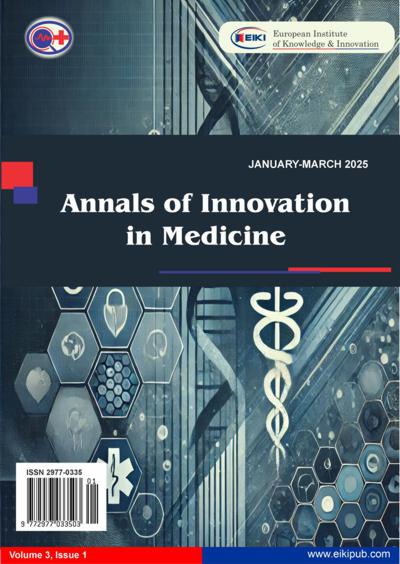Therapeutic Effect of Aqueous Allium Cepa Extract on Ethanol-Induced Hepatotoxicity in Albino Rats
Main Article Content
Abstract
In recent years, alcohol consumption has seen a significant rise, particularly driven by social activities. However, chronic alcohol intake has been widely recognized as a major risk factor for the development of numerous diseases, particularly liver disease. This study aimed to evaluate the therapeutic effect of aqueous extract of Allium cepa (onion) on ethanol-induced hepatotoxicity in albino rats. A total of twenty-five rats, weighing between 130-180g, were randomly assigned into five groups, each containing five rats. The rats were given a 14-day acclimatization period with free access to standard feed and water before the experiment. Group I served as the negative control and received only standard feed and water. Group II, the positive control, was administered 50% ethanol orally at a dose of 0.5 ml/100g body weight. Groups III, IV, and V received the same ethanol treatment, followed by oral administration of 200mg/kg, 400mg/kg, and 600mg/kg of aqueous Allium cepa extract, respectively, once daily for 30 days. At the end of the experiment, the rats were anesthetized using chloroform, and blood samples were collected for the analysis of liver enzymes, including aspartate aminotransferase (AST), alanine aminotransferase (ALT), alkaline phosphatase (ALP), and gamma-glutamyl transferase (GGT) using enzymatic methods. The livers were also excised for histological analysis using hematoxylin and eosin (H&E) staining. Statistical analysis was performed using SPSS version 24, with significance set at p<0.05. The results revealed a significant reduction in the levels of AST (p=0.000028), ALT (p=0.00003), and GGT (p=0.000050) in the groups treated with Allium cepa extract compared to the positive control group. However, no significant differences were observed in ALP levels (p=0.610) across all groups. These findings suggest that aqueous Allium cepa extract may have ameliorative potential against ethanol-induced liver toxicity, possibly due to its antioxidant properties.
Downloads
Article Details

This work is licensed under a Creative Commons Attribution 4.0 International License.
References
Room R, Babor T, Rehm J. Alcohol and public health. Lancet. 2005;365(9458):519-30. https://doi.org/10.1016/S0140-6736(05)17870-2
Khamis AA, Salleh SZ, Ab Karim MS, Mohd Rom NA, Janasekaran S, Idris A, Abd Rashid RB. Alcohol consumption patterns: A systematic review of demographic and sociocultural influencing factors. Int J Environ Res Public Health. 2022;19(13):1-17. https://doi.org/10.3390/ijerph19138103
Carbia C, García-Cabrerizo R, Cryan JF, Dinan TG. Associations between mental health, alcohol consumption and drinking motives during COVID-19 second lockdown in Ireland. Alcohol Alcohol. 2022;57(2):211-8. https://doi.org/10.1093/alcalc/agab067
Shield KD, Parry C, Rehm J. Chronic diseases and conditions related to alcohol use. Alcohol Res Curr Rev. 2013;35(2):155-73.
Chalasani N, Younossi Z, Lavine JE, Charlton M, Cusi K, Rinella M, et al. The diagnosis and management of nonalcoholic fatty liver disease: Practice guidance from the American Association for the Study of Liver Diseases. Hepatology. 2018;67(1):328-57. https://doi.org/10.1002/hep.29367
Teschke R. Alcoholic liver disease: Alcohol metabolism, cascade of molecular mechanisms, cellular targets, and clinical aspects. Biomedicines. 2018;6(4):1-57. https://doi.org/10.3390/biomedicines6040106
Marefati N, Ghorani V, Shakeri F, Boskabady M, Kianian F, Rezaee R, Boskabady MH. A review of anti-inflammatory, anti-oxidant, and immunomodulatory effects of Allium cepa and its main constituents. Pharm Biol. 2021;59(1):287-302. https://doi.org/10.1080/13880209.2021.1874028
Liu SY, Tsai IT, Hsu YC. Alcohol-related liver disease: Basic mechanisms and clinical perspectives. Int J Mol Sci. 2021;22(10):1-27. https://doi.org/10.3390/ijms22105170
Tulunay M, Aypak C, Yikilkan H, Gorpelioglu S. Herbal medicine use among patients with chronic diseases. J Intercult Eth-nopharmacol. 2015;4(3):217-20. https://doi.org/10.5455/jice.20150623090040
Hong M, Li S, Tan HY, Wang N, Tsao SW, Feng Y. Current status of herbal medicines in chronic liver disease therapy: The biological effects, molecular targets and future prospects. Int J Mol Sci. 2015;16(12):28705-45. https://doi.org/10.3390/ijms161226126
Marrelli M, Amodeo V, Statti G, Conforti F. Biological properties and bioactive components of Allium cepa L.: Focus on po-tential benefits in the treatment of obesity and related comorbidities. Molecules. 2018;24(1):1-18. https://doi.org/10.3390/molecules24010119
Denton L, Ojeifo IM. Onion production practices and their improvement in Nigeria. Onion Newsl Trop. 1990;1(2):10-3.
Lodhi P, Tandan N, Singh N, Kumar D, Kumar M. Camellia sinensis (L.) Kuntze extract ameliorates chronic ethanol-induced hepatotoxicity in albino rats. Evid Based Complement Alternat Med. 2014;2014(1):1-7. https://doi.org/10.1155/2014/787153
Organization for Economic Cooperation and Development (OECD). Guidance document on acute oral toxicity testing. Available at: https://www.ivami.com/en/biological-evaluation-of-medical-devices-medical-devices/7508-285-acute-oral-toxicity-test-fixed-dose-procedure-oecd-420-2001-guidance. Assessed on 23 June 2024.
Ibama O, Onwuli DO, Ben-Chioma AE, Konne FE, Nwachuku EO. Comparative effects of sildenafil citrate and Revive capsule on some liver and kidney parameters in male albino rats. Am J Biomed Sci Res. 2021;13(4):148-55. https://doi.org/10.5099/aj210400148
Ibama O, Konne FE. Oncogenicity of tobacco-smoking: A review on squamous cell carcinoma of the tongue, diagnosis and treatment. World J Pharm Life Sci. 2018;4(12):1-6.
Formica JV, Regelson W. Review of the biology of quercetin and related bioflavonoids. Food Chem Toxicol. 1995;33(12):1061-80. https://doi.org/10.1016/0278-6915(95)00077-1
Hassan HA, El-Gendy AM. Evaluation of silymarin and/or ginger effect on induced hepatotoxicity by carbon tetrachloride in male albino rats. Egypt J Hosp Med. 2003;12(1):101-12. https://doi.org/10.12816/EJHM.2003.18251
Dibal NI, Garba SH, Jacks TW. Onion peel quercetin attenuates ethanol-induced liver injury in mice by preventing oxidative stress and steatosis. Biomed Res Ther. 2022;6(4):269-76. https://doi.org/10.15419/bmrat.v9i6.745
Ogunlade B, Saalu LC, Ogunmodede OS, Akunna GG, Adeeyo OA, Ajayi GO. The salutary role of Allium cepa extract on the liver histology, liver oxidative status and liver marker enzymes of rabbits submitted to alcohol-induced toxicity. Am J Biochem Mol Biol. 2012;2:67-81. https://doi.org/10.3923/ajbmb.2012.67.81
Ozougwa J, Eyo JE. Hepatoprotective effects of Allium cepa (onion) extracts against paracetamol-induced liver damage in rats. Afr J Biotechnol. 2014;13:2679-88. https://doi.org/10.5897/AJB2014.13815
Sunderman FW Jr. The clinical biochemistry of 5'-nucleotidase. Ann Clin Lab Sci. 1990;20(2):123-39.

